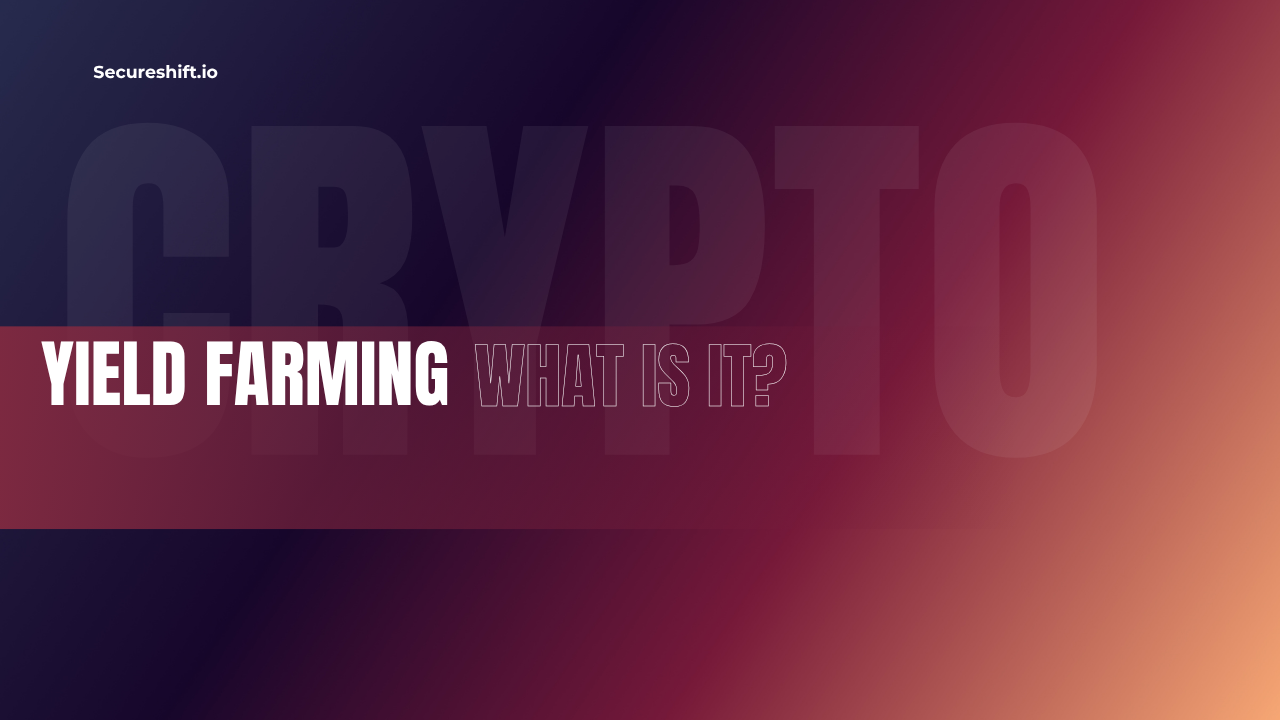
What is yield farming?
The unique word "crypto" continues to surprise its community members. Not long ago, a new method of profiting from your investments emerged known as "yield farming". In this essay, we'll learn what yield farming is, how it works, and whether it's worth investing in.
Table of Contents
What is Yield Farming?
Yield farming is a mechanism in which cryptocurrency holders can pool their cash with other users to seek financial gains. The method is often comparable to depositing money at a bank, with the primary distinction being that in a farming system, your funds are locked for a set amount of time. The process is known as "staking". Users generally receive interest for lending their cryptocurrency. The method is extremely dangerous, but its players stand to benefit greatly.
The potential profit comes with significant risks, as protocols and currency are exceedingly volatile. Don't forget about rug pulls, which occur when developers depart projects, leaving investors without their benefits.
Yield farms may be found on DeFi platforms or cryptocurrency exchanges.
Now that we know what yield farming is, let's look at how it works.
How Does Yield Farming Work?
An investor invests their cryptocurrency via a 'loan protocol' via a dApp. The liquidity is now available, and other investors can borrow it to fund their own investments.
Yield farming rewards early investors, and governance tokens for that blockchain are frequently distributed to keep them as users and to maintain their liquidity in the system. Users of the decentralized system can vote on any new legislation. These governance tokens, which are issued as a reward for yield farming, are crucial since they are at the heart of any DAO or user-run project.
Liquidity pools keep the ecosystem alive because smaller projects provide the majority of the initial liquidity.
Do you want to know how to yield farm? There is a list of steps taken in the process of yield farming.
- Yield farming begins with the establishment of a liquidity pool, which is based on a smart contract that facilitates all investment and borrowing for the specific yield farm.
- Investors stake their assets by linking their wallets to the pool.
- Smart contracts facilitate a variety of functions, like adding liquidity to a bitcoin exchange market and lending to others.
- As a result, participants are compensated with interest, which varies depending on the yield farm. Set regular intervals or particular dates for payment, and then receive your incentives on the website.
Types of Yield Farming
Liquidity provider:
To provide trading liquidity, consumers deposit two coins with exchanges. The exchange charges a small fee to liquidity providers for swapping the two tokens. The fee is sometimes paid using liquidity tokens.
Lending:
Holders lend cryptocurrency to borrowers via a smart contract and receive interest on the transaction.
Borrowing:
It is possible to use one token as collateral while receiving a loan from another. The farmer maintains their holding while also receiving a yield on the borrowed coin.
There are two types of staking.
The most common occurs on proof-of-stake blockchains, where a user is compensated with interest for pledging their tokens to the network. This is designed to ensure security. The second option is to stake liquidity pool tokens earned by providing liquidity to exchanges. This allows the supplier to gain yield twice.
What are the benefits of yield farming?
The history of yielding commences in 2020, and holders were able to boast about triple-digit APY rates, which is rare among non-crypto users. Nevertheless, these rates generate substantial volatility, which implies that there are undoubtedly hazards. We will delve further into this matter at a later time.
Nevertheless, the profitability of yielding remains contingent upon the amount of time, money, and effort invested. In order to be most effective, it is also necessary to have a comprehensive understanding of DeFi platforms and other products.
To generate passive income, it is advisable to invest in a reputable platform or liquidity pool in order to evaluate its performance. You may transition to other investments once you have achieved a certain level of confidence.
Risks of Crypto Yield Farming
In order to engage in a market that is entirely speculative, a greater level of risk tolerance is necessary. The other risk factor is that yield farming is conducted on decentralized exchanges.
Rug Pulls
Rug pulls are the result of developers abandoning their crypto projects and failing to repay the money they have invested to previous users. The nature of the initiatives in which yield farmers typically engage places them at a significant risk.
Bugs or vulnerabilities in smart contracts
Farmers are rendered susceptible to thefts and hacks in the event that the flaw manifests.
Temporary decline
In theory, investors may experience a greater loss than their initial investment, as the farmer's currency continues to fluctuate in accordance with its market value.
Unpredictability
Crypto volatility is highly unpredictable; it can experience both significant increases and declines while your funds are invested, and you are powerless to influence it.
Regulatory risk
The situation regarding crypto regulation remains ambiguous, as the SEC has accused certain assets of being securities, which complicates the process.
Is it worthwhile to engage in yield farming?
In order to achieve success in yield farming, it is crucial to possess a viable strategy and be enthusiastic about generating an income. In order to enhance your experience, it is advisable to first research yield farming crypto lists or the top yield farming crypto platforms. Chasing the highest potential yield should be your objective. The other important factor to consider is that it is only profitable if you are prepared to invest a substantial amount of money; otherwise, your income will be offset by petroleum fees. Although the prospect of earning doubled or even tripled sums may be appealing, it is not a wise decision if one is unaware of potential risks and lacks a fundamental understanding of yield algorithms.
Benefits and Drawbacks of Yield Farming Benefits
The potential for high interest:
- There is a possibility of earning an annual percentage yield (APY) exceeding 100%.
- Based on smart contracts: A intermediary is unnecessary when smart contracts are implemented. The transaction is feasible provided that the participant possesses a wallet that is compatible.
- A component of a DeFi system: Participation in an innovative DeFi system.
- Drawbacks
Impermanent loss risk:
- Your losses will be impermanent if the price of the cryptocurrency you have secured decreases.
- Scams and hacks: It is possible that it is hazardous, as is the case with any aspect of the cryptocurrency ecosystem.
- Challenges associated with tax reporting: The complexity of administering crypto transactions is further compounded by yield farming.
How to Begin Yield Farming
The following are the measures to engage in yield farming independently:
- First, investigate potential yield-farm investments. There are numerous yield farming platforms from which to select.
- Fund your account or connect your wallet: Ensure that your wallet is compatible with yield farming in order to participate.
- Stake your cryptocurrency: Lock your funds for a specified period of time by staking them.
- Collect your earnings: The process of accumulating rewards is contingent upon the yield farm that has been selected.
Concluding thoughts
Yielding cryptocurrency is a hazardous endeavour, as it entails the locking up of one's crypto assets in order to generate interest. Your level of risk tolerance is the primary factor determining your success in yield farming. The individuals who are most diligent about their farms are benefiting the most and experiencing the least amount of loss.
Start a cryptocurrency exchange jounery . Try our crypto exchange platform. Click here
Disclaimer: It is important to note that the content of this article does not constitute financial or investment advice. The views expressed herein are solely those of the author and should not be interpreted as specific recommendations for trading or investing. Readers and visitors to the website are encouraged to explore various perspectives and familiarize themselves with relevant local regulations prior to engaging in cryptocurrency investments. We do not guarantee the reliability or accuracy of the information presented.



